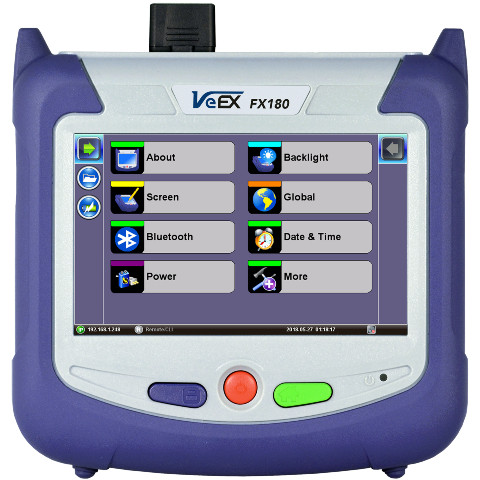Micro Optical Spectrum Analyzer for CWDM or DWDM Fiber Network Testing
Available in two test configurations, CWDM or DWDM C-band, the FX180 measures key parameters such as wavelength, channel power, drift and OSNR. This compact, robust, lightweight tester offers various test modes such as Spectral Analysis, Drift Analysis, Channel ON / OFF in-band OSNR and Channel Checker and an optional Fiber Scope for checking connectors.
Highlights
Specifications
Download
Key Features
- Robust, handheld design for field environments
- High resolution, 5” TFT color touch-screen for easy viewing
- Intuitive display, simple function keys and touch-screen for fast navigation and easy operation
- Internal data storage with expandable SD card
- Micro-USB OTG interface for flash drives, fiber inspection probe connection and test data transfer
- Rechargeable Lithium Polymer battery with capacity indicator, low voltage alarm and Auto-off function
- > 9 hours continuous operation without recharging batteries
- Built-in WiFi option to perform software upgrades
- Built-in Bluetooth option for pairing applications with Mobile Smartphones and Tablet PCs
Key Specifications
- Table View, Spectrum View, Channel Drift Analysis, Channel ON / OFF and Channel Drift Analysis
- Precise Wavelength, Signal Level and OSNR required to confirm DWDM network service quality
- Built-in wavelength reference
- Sweep time < 5 seconds
- Simultaneous measurements of up to 96 channels @ 50 GHz
- DWDM channel spacing down to 50 GHz
- Generate and save test results in HTML file format
- Single or Continuous Repeat Sweep
- High wavelength accuracy: ± 50 pm
- Dynamic Measurement range: ≥ 65 dB
- *OSNR measurement range: 10-40 dB
- **Special noise filter (iOSNR) for improved noise measurement
- Low Polarization Dependent Loss (PDL): < 0.3 dB
- DWDM Optical Rejection Ratio: > 40 dB @ 200 GHz
- Optional universal interface with interchangeable adaptors
- OSNR measurements per IEC 61280-2-9
- CWDM channel measurements per ITU-T G.694.1 grid
- DWDM C-Band channel measurements per ITU-T G.694.1 grid
OSNR values depend on source level, modulation and channel spacing Applying noise filter can improve OSNR results up to 3-5 dB @ 100 GHz and up to 10-15 dB @ 50 GHz

